| Label | Notes | Images |
| Ace |
An early
"acetate" disc, the example here dates from 1937, based on the tune
titles. Cecil Watts, who developed this type of disc recording in the
1930s, has been reported as saying that film studios bought his
recording machines, and this may be the product of one of those studios. Whether the recordings on this (and other similarly labelled) records are from film soundtracks, I cannot say. Thanks to Bill Dean-Myatt for the label scan. |
|
| Aco |
Aco was a product of the Aeolian
(subsequently Vocalion) Company Ltd at Aeolian
Hall, Bond Street, London. It was aimed at the popular cheaper
record buying market and was available from November 1922 until August
1927. The catalogue for 10" records was from G-15001 up to G-16230.
The label design changed little over the five years except to become
larger in about 1925. 12" ACO records used an F-33000 series catalogue number series. British recordings were generally made specifically for ACO by the Vocalion Company. These have a C-5000 series matrix number and were acoustic until 1926 when electrical recordings, using the Marconi system were introduced and the matrix numbers started at C-1-E. American masters came from American Vocalion, Emerson and Gennett and are mainly acoustical recordings, though the later ones from both Vocalion and Gennett are electric. |
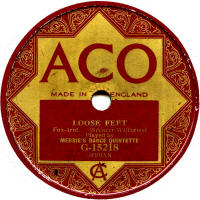 |
| Actuelle |
Actuelle was a product
of Pathe Freres and was Pathe's "needle-cut" disc (i.e. lateral
cut grooves) as opposed to vertical cut or "hill and dale" as
it is now often referred to. Actuelles appeared in Britain in September 1921 and lasted until December 1928. The records used English, French and American Pathe masters throughout. Initially, these were dubbed from a master cylinder recording, generating quite considerable "cylinder rumble" on some records. The surfaces of the records were always very smooth, though. The English masters were in a 78000-79000 and 90000 series, the American ones ran from 68000 to 70000, then restarted at 105000, reaching somewhere in the 108000 range. French matrices were in a 5000-6000 block. Electrical recording came quite late; only one or two English matrices on Actuelle are electric; the American masters went electric at about 107100, though some early electrics have matrices in an E-2000 range. All English dance records are by studio bands led by Wag Abbey, though the electrics are actually French bands (despite having English matrix numbers); American ones include the usual Sam Lanin, Lou Gold, Ben Selvin etc. There was quite a lot of interesting Jazz issued, such as The Red Heads and The Original Memphis Five. Columbia bought the English branch of Pathe in December 1928; it is conceivable there may be some late Actuelles pressed by Columbia using their superior laminated technique. Certainly some of the last "Perfect" records (q.v.) may be found with fine laminated surfaces. A full listing of this label is currently available from the CLPGS. |
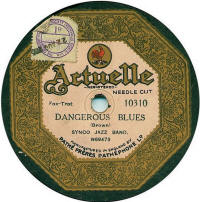 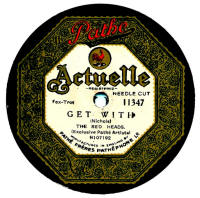 |
| Addisco |
This would appear to be a one-off issue, containing two
transfers of rare 1920s jazz recordings from Paramount. The label gives
no details about the producer or the reason for the issue, and no
catalogue numbers. The reverse side is the Midway Garden Orchestra
playing Black Sheep Blues. Thanks to Bill Dean-Myatt for the image. |
|
| Addison |
An independent label from the late 1940s. Addison records
were 12" in size, cost 7/6 and were pressed in vinyl and they
concentrated on new Jazz recordings by local bands from the Manchester
area. The label was owned by Noah Ancill and the records were distributed by
Messers Hime and Addison of 37, John Dalton Street, Manchester, who also
marketed the SLRC label (q.v.). Thanks to Robert Girling for the label image. |
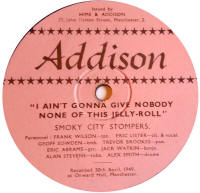 |
| Adelphi |
This extremely rare British
label is also one I know little about, other than it is from the
Vocalion stable like Beltona, Guardsman, etc. It may have been produced
for export only, judging by their scarcity. Label scan kindly supplied by Richard Johnson, from an original record belonging to Steve Paget. |
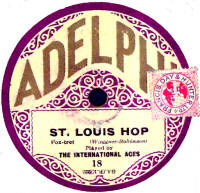 |
| Aden Crown |
Manufactured in England for the Middle East, presumably Aden.
I'm guessing it was made by Decca or Crystalate, depending on the date
of the pressing. Thanks to Bill Dean-Myatt for the image. |
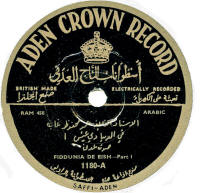 |
| Adprint | Frank Andrews (in Hillandale News 213) reports that these are 7" children's records playing at 78rpm. They were produced by E.R.D. Studios | |
| Aeolian Vocalion | This is the full name shown on early Vocalion labels; see Vocalion for all information. | |
| Aerial |
An very scarce label, Aerial
was a so-called unbreakable record manufactured by Duophone and using
the same masters and pseudonyms as the Duophone M- series. It would appear that only one issue of 6 records was ever produced, and probably only a small number of each was manufactured. It is reasonable to assume these were made for a specific client, such a shop, but to date, who this might be is unknown. |
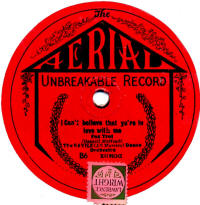 |
|
Aerona (sold in Australia) |
A 7" disc manufactured by
Crystalate in England for export to Australia for Salkfeld & Walllace
Ltd of 119, Clarence Street, Sydney. They were available
from 1926 to about 1928, and used mainly (if not completely) English
masters recorded in London. My thanks to Derek Kell for the label scan. |
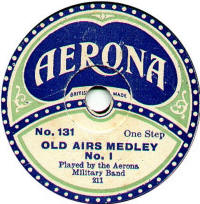 |
| AFMC |
A British Educational record,
produced for the Anglo French Music Company. These records date from 1923
- 1925 and were recorded and manufactured initially by Vocalion UK
(1923), and later by Parlophone (1924-25). The catalogue series was in a
2000-range, irrespective of the record's size. The majority of the records were of piano music, graded to match the examination of the Associated Board of the Rouyal Academy of Music andthe Royal College of music. The records were of 10" and 12" in diameter; the 10" cost 3/6 and 12" were 5/-. Thanks to Bill Dean-Myatt for the label image. |
|
| Afrikander |
A
British-produced record made by Edison Bell UK for export, presumably to
South Africa. As such, I would date it to the early 1930s. Thanks to Bill Dean-Myatt for the label image. However, due to the usual problem with digitising gold-on-red labels, I have had to mess with the settings somewhat; in reality the label is a much deeper red, more like the Edison Bell Winner of the period. |
|
| AGA |
A rare
German-produced label dating from Pre-WWI. Catalogue numbers were in a
5000-series. Thanks to Bill Dean-Myatt for the label scan. |
|
| Ajax |
It is not even certain that these
records ever appeared. The Ajax Record Manufacturing Co Ltd of 54, Red
Cross Street, London were incorporated on May 11th, 1914 and they
announced their records would be on sale in July 1914. It is possible
that there was a delay and that the outbreak of WWI in August prevented
any records being produced, as it is believed the records would have been
pressed in Germany by Berolina.. John Abrahams was a director of the
company (see "Invicta"). A label scan or details of any records would be most welcome ! |
|
| Albion |
A fairly scarce pre-first world war "British" label actually produced by
the German Lindström organisation from 1912. Many would be made at the
factory in Hertford and thos would have "Manufactured in England"
on the label. Some may be found as label
paste-overs on John Bull records. As you'd
expect, there's no Dance Band material as the label pre-dates that style
of music, though some Ragtime music may be found. The catalogue numbers were in a 1000 series.
Albion records are believed to have been sold by the "tallyman" system. This is surprising as Beka, who produced them, had just introduced their price-busting Coliseum & Scala records in order to undercut the companies such as John Bull who sold their records this way. |
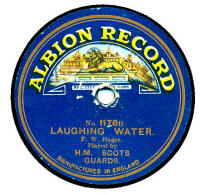 |
| Alexander |
A scarce label from pre-WWI. This one actually states "Made in
Germany" though the labelling is all in English. It is thought to
have been produced for the Alexander Record Company of Birmingham,
Chester, Coventry & Manchester. The catalogue series are the same as the Beka discs from whence the masters are all derived. They started at 1 or 100; the highest known being 478, the Beka issue of which was issued in late 1911. Alexander were not advertised in the trade journals of the time, leading to suspicion that it may have been a "tallyman" label, sold directly to customers, like John Bull records. |
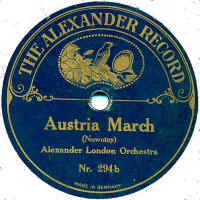 |
| Allegro |
A
product of English Decca, made for export to France. The example shown
dates to the early 1930s, but I don't know for how long this label was
in production. Thanks to Bill Dean-Myatt for the label image. |
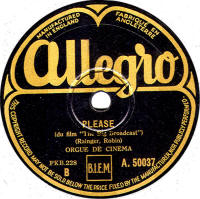 |
| Ambassador |
Probably from post-WWII, these were made in England, maybe by Decca, for
export. Thanks to Bill Dean-Myatt for the label image. |
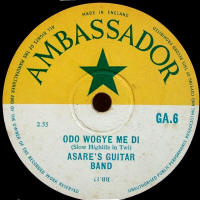 |
| American Odeon | Made in the U.S. and imported into Britain from 1905, these were advertised as "Blue Odeon Duplex Records" as they were manufactured from a dark blue shellac. The records were (obviously) double-sided, but had face numbers but no catalogue number. They were 10½" in diameter and sold for 5/-. At this price, it is not surprising they are scarce! |
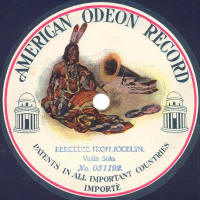 |
| Anchor |
A German import from
1912-1914, the original records were called "Anker" in Germany
but imported to England by the Anchor Gramophone Co of 14-16 Scrutton
Street, London. Thanks to Norman Field for the label image. |
|
| Anchor Phonogram |
Another German import from
1912-1914. These were 12" records, presumably the equivalent to the 10"
"Anchor" record above. Thanks to Bill Dean-Myatt for the label scan |
|
| Angel |
An
EMI-produced label dating from the 1950s. These were manufactured for
export, possibly to America where the "His Master Voice" name and trade
mark was owned by RCA, who split from EMI during the 1950s. Recently, the second style was found in Hong Kong, but nothing is known about its origins, despite the "British Made" statement on the label. Thanks to Bill Dean-Myatt for the first label scan; the oriental one was taken from "For The Record" No. 28. |
_small.jpg) |
| Anonymous |
One of a number of labels with no name from the pre-WWI period. There
are plenty of examples of German-made records from this time which have
multiple languages on the labels, often including English, but there is
no proof they were ever sold in England. However, this first example is odd in that it has the titling twice, but both are in English, so I am including it in the likelyhood it was available in England, though this example image has been sent to me from New Zealand, so who knows! Thanks to Adam Miller for this image. The second image, courtesy of John Culley, originates from Operaphone. Curiously, though, the catalogue number of 113 does not match that of the original Operaphone issue, which was 106. Similar enough to be somewhat confusing! |
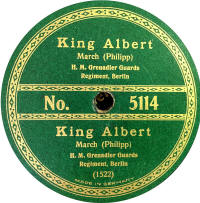 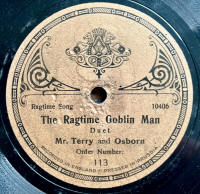 |
| Antone | A post-WWII label recorded and produced by The Antone Company of Epsom, Surrey for sale by F & E Stoneham, booksellers to the motorist. The example seen by Frank Andrews (Hillandale News 214) was a 10" shellac 78. | |
| Apollo |
A rare pre-WWI
label, produced for Craies & Stavridi of 101, Bunhill Row, London.
There were two known catalogue series, but it has not yet been established which series came first, or whether they ran concurrently. One started at 1 and ran for about 300 issues. These were initially pressed by and used masters from Edison Bell, from their "Bell", "Velvet Face" or "Winner" labels. This continued up to at least No. 130. The few reported with numbers in the 160s & 170s were made in Germany using Globophon masters. Then from about 190 onwards, Edison Bell took over again up to the highest known; at least some of these later ones have a plain red label (as shown). The other series started at 10001 ("Apollo Green Label") and probably ran for about 100 issues These were manufactured in Germany and used masters from Kalliope. Obviously these date from pre-WWI. |
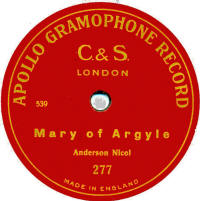 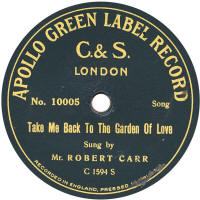 |
| Apollon |
A rare pre-WWI
label, produced for Craies & Stavridi of 101, Bunhill Row, London,
who also sold "Apollo" records (see above).
In the autumn of 1907, recording expert Sidney Taylor travelled to Greece
and Turkey to make these recordings. The records, though (it is assumed)
only being sold in those countries, were made in England, as the image
shows. It is not clear who manufactured the records, but it wasn't
Edison Bell, so maybe Crystalate? Thanks to Dave Mason for the first label image, and to Rainer Lotz for the second. The red labelled image actually has gold printing, but I couldn't get it to show digitally, so I've had to mess with the contrast to make it readable! |
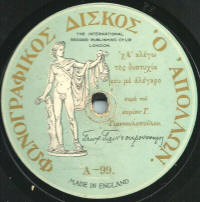 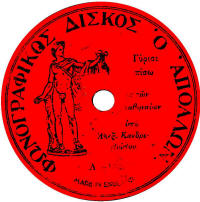 |
| Ariel |
The Ariel
Grand Record (to give it the correct title) was produced for Messrs J.
G. Graves of Sheffield, England, who sold them on a mail order basis.
The label was available from 1910
until 1938, an amazing length of time for a store label.
The masters came from many sources
over the years. The early ones from Beka, Favourite, Grammavox & Jumbo; occasionally
the label is found to be just a paste-over (I have a John
Bull with an Ariel label pasted over it), and examples have been found
as Winners with Ariel paste-overs, from the early 1920s. In the later 1920s, was a 1000 series,
again from Zonophone issued sides by the various Bert Firman groups (see
picture 1.) The label design changed little over
the years as can be seen by the pictures here. Finally, the Ariel Concert is a 12" issue. Thanks to Bill Dean-Myatt for the scan. Thanks to the generosity of discographer & researcher Mike Langridge, I have been able to produce a reasonable attempt at listing this very complicated and extensive label. In addition, I have added the most familiar 1920s-30s "Parlophone" Ariels, courtesy of Steve Walker and the late Arthur Badrock. |
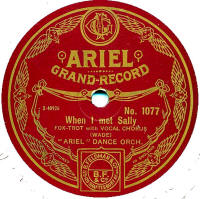 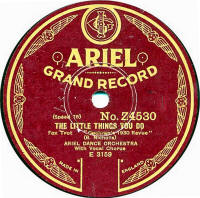 |
| Argo | Better remembered these days as a budget LP (and now CD) label, Frank Andrews reports in Hillandale News 214 the existence of 10" and 12" 78rpm records from the 1950s. | |
| Arrow |
An early British label pressed
by the Carl Lindström group using Beka masters (often of an earlier
vintage), Arrow existed from 1913 up to about 1916. It was a cheap line
costing 1/1 or 1/- from The Scala Record company, introduced as a result
of the Cinch and Phoenix records costing 1/1 produced by the Gramophone
Company & Columbia, which themselves were a response to Lindström's
Scala and Coliseum 1/6 records! The catalogue series was numbered A1 upwards to about A224. The label was either Red or Yellow. The Red labelled ones are earlier and were all manufactured in Germany. The yellow ones were made both in Germany and at Hertford, England, where Lindström had a record manufactory built in London in 1913.; some yellow labelled Arrows do not state a place of manufacture. |
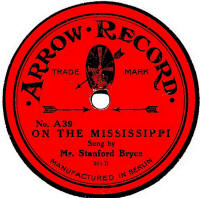 |
| Artiphon |
A German record label that made it's first appearance in 1919;
Its inclusion here is based solely on the example shown right, which has
a British Copyright stamp on the label, and therefore was sold in this
country. Whether it was a personal import, or the records were generally
imported and sold in Britain is not known, but I've not seen any other
examples in over 40 years of record collecting! My thanks to Norman Field for the label image. |
_small.jpg) |
| Aspir |
The Aspir Disc was a French-manufactured record; "Aspir" being
an anagram of "Paris". First mentioned as being available in the UK in
May 1909 and withdrawn in April 1911, Aspir Discs were vertical-cut
(Phono) with an etched-and-filled "label" similar to Pathe discs of the
time. They were sold in 11" and 12" sizes for 3/6 and 3/9 respectively.
Manufactured by Establissements Phonographiques D'Ivry, all the
recordings were French, and the records sold by Aspir (London) Ltd, of
15, Victoria Street, London. This was the trading address of George
Davies, who had been the agent for the French-made Phoebus and
Phono Disc records in 1908. I am assuming they are "labelled" as Aspir Disc (rather than the French "Disque Aspir"), so an image of any plus any information would be very useful ! |
|
| Assimil |
A language label, in this case for learning German, produced by
EMI, dating to the early 1950s. French language courses were also
available on Assimil. My thanks to Bill Dean-Myatt for the label image. |
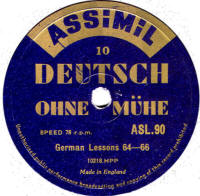 |
| Auto Record | This was an 8" single-sided record manufactured by Beka Records in Germany, first advertised in the UK trade magazines in July 1905 and therefore assumed to have sold here, though I have never seen any other reference, or image of one. Described as "the cheapest record in the world", they sold for 6d and were "unbreakable", being described as "card, with a hardened playing surface", so presumably a bit like the 1930s Durium records maybe? They were most likely to have only been available for a short period, probably during 1905 only. | |
| Autograph |
Not to be
confused with the rare American 1920s label, Autograph records in
Britain date from pre-WWI. Comedian Billy Whitlock was involved in the
venture which seems to have been very short-lived. All those seen are by
Billy Whitlock and were sold through W. H. Reynolds Ltd. They were not
original recordings, but from various sources, for which Whitlock must
have retained some sort of mechanical rights. It is believed there were
36 different records sold. The label shows Billy Whitlock's autograph
and the masters came from Beka, Dacapo, Favorite & Polyphon. (The
example shown is from Favorite 272. The Autograph label has just been
pasted over an unlabelled original, a most unusual example). Thanks to Bill Dean-Myatt for the label scan. |
|
| A W Gamage | see under "Gamage" |